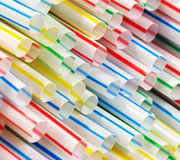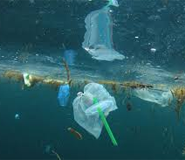Final Straw for Single Use Plastic
 Over the last month, the national and global fight against plastic straws has been waged in a major way. Everyday we’re adding a name to the long list of companies that are vowing to ban plastic straws - Starbucks, Marriott International, McDonald’s, Hyatt, American Airlines, and Lettuce Entertain You Group to name a few. While plastic straws have always seemed innocuous, a 2015 viral video showing rescuers extracting a straw from a Loggerhead Turtle’s nostril started a firestorm of outrage, and the fire is growing. As more companies, and even entire cities, join the anti-straw movement, it seems like a good time for anyone who hasn’t jumped on the bandwagon to heed the words of Bob Dylan, “There’s a battle outside and it is ragin’. It’ll soon shake your windows and rattle your walls, for the times they are a-changin’”.
Over the last month, the national and global fight against plastic straws has been waged in a major way. Everyday we’re adding a name to the long list of companies that are vowing to ban plastic straws - Starbucks, Marriott International, McDonald’s, Hyatt, American Airlines, and Lettuce Entertain You Group to name a few. While plastic straws have always seemed innocuous, a 2015 viral video showing rescuers extracting a straw from a Loggerhead Turtle’s nostril started a firestorm of outrage, and the fire is growing. As more companies, and even entire cities, join the anti-straw movement, it seems like a good time for anyone who hasn’t jumped on the bandwagon to heed the words of Bob Dylan, “There’s a battle outside and it is ragin’. It’ll soon shake your windows and rattle your walls, for the times they are a-changin’”.
 It’s estimated that 60% of all single-use plastic manufactured since the mid-1950’s is now in landfills or the natural environment, like the ocean, and that by 2050 there may be more plastic in the ocean than fish. While the actual usage numbers for plastic straws specifically are up for debate, the Ocean Conservancy’s sites plastic straws as their 7th most collected item during their 2017 International Coastal Cleanup. And it was a lot of straws – I’m talking equal to 145 times the height of One World Trade Center! It’s true that there are bigger problems, like cigarette butts which came in as the #1 most collected item, but many supporters of the spreading single-use plastic straw ban agree, every little bit helps. And if people give up plastic straws, which aren’t a necessity for most people (excluding individuals who require bendable plastic straws due to disabilities), maybe they’ll consider their plastic grocery bags or bottles too.
It’s estimated that 60% of all single-use plastic manufactured since the mid-1950’s is now in landfills or the natural environment, like the ocean, and that by 2050 there may be more plastic in the ocean than fish. While the actual usage numbers for plastic straws specifically are up for debate, the Ocean Conservancy’s sites plastic straws as their 7th most collected item during their 2017 International Coastal Cleanup. And it was a lot of straws – I’m talking equal to 145 times the height of One World Trade Center! It’s true that there are bigger problems, like cigarette butts which came in as the #1 most collected item, but many supporters of the spreading single-use plastic straw ban agree, every little bit helps. And if people give up plastic straws, which aren’t a necessity for most people (excluding individuals who require bendable plastic straws due to disabilities), maybe they’ll consider their plastic grocery bags or bottles too.
With more people paying attention, some companies are diving all in. Starbucks recently announced a plan to eliminate all plastic straws by 2020, replacing them with recyclable lids and paper straws – eventually eliminating nearly 1 billion plastic straws a year. Additionally, just last week, Marriott International announced their intentions to remove the product from all their properties by this time next year. Even entire cities are hitching their wagon to the effort, including Starbuck’s hometown, Seattle, WA, and my home of St. Petersburg, FL.
But what affect will this ban have on the hospitality industry? And further, is all this effort really worth it?
 Some critics of the ban state that offering alternatives, like paper or metal straws, will ultimately cost them more money – a cost they will be forced to transfer to the consumer. Not only are they incurring a cost for product, but bars and restaurants operating in cities where a full ban has been put in place also face fines from the city if they buck the law and continue to offer plastic. Critics also site statistics that most of the plastic waste in the ocean comes from Asia, and that America is only responsible for a small part of that pollution. While that may be true, it’s worth asking; couldn’t a small change lead to a larger, global change?
Some critics of the ban state that offering alternatives, like paper or metal straws, will ultimately cost them more money – a cost they will be forced to transfer to the consumer. Not only are they incurring a cost for product, but bars and restaurants operating in cities where a full ban has been put in place also face fines from the city if they buck the law and continue to offer plastic. Critics also site statistics that most of the plastic waste in the ocean comes from Asia, and that America is only responsible for a small part of that pollution. While that may be true, it’s worth asking; couldn’t a small change lead to a larger, global change?
It’s obvious that the environmental movement is here to stay, and I can’t help but remember a rule my mother used to teach me: Leave things better than how you found them.
